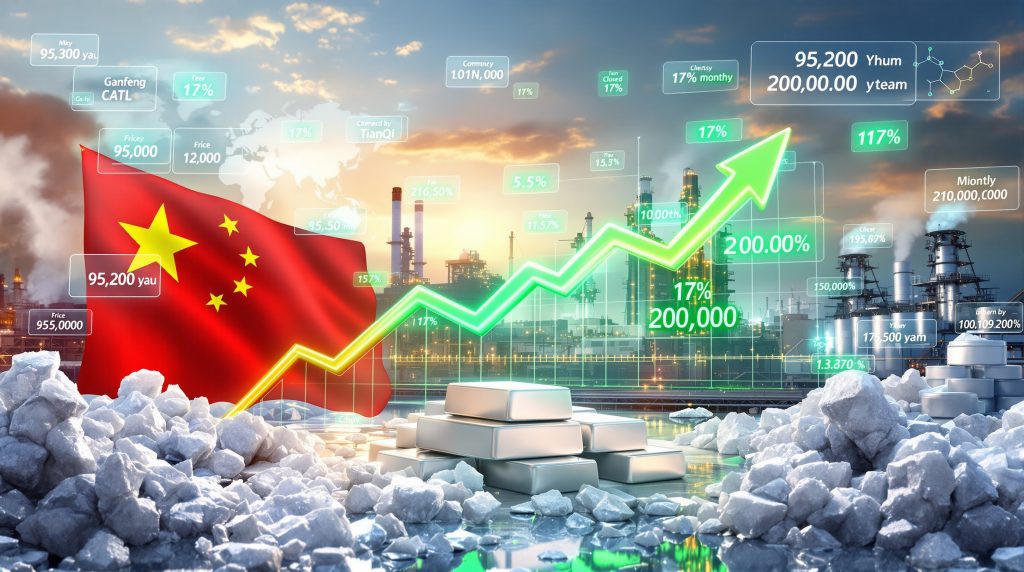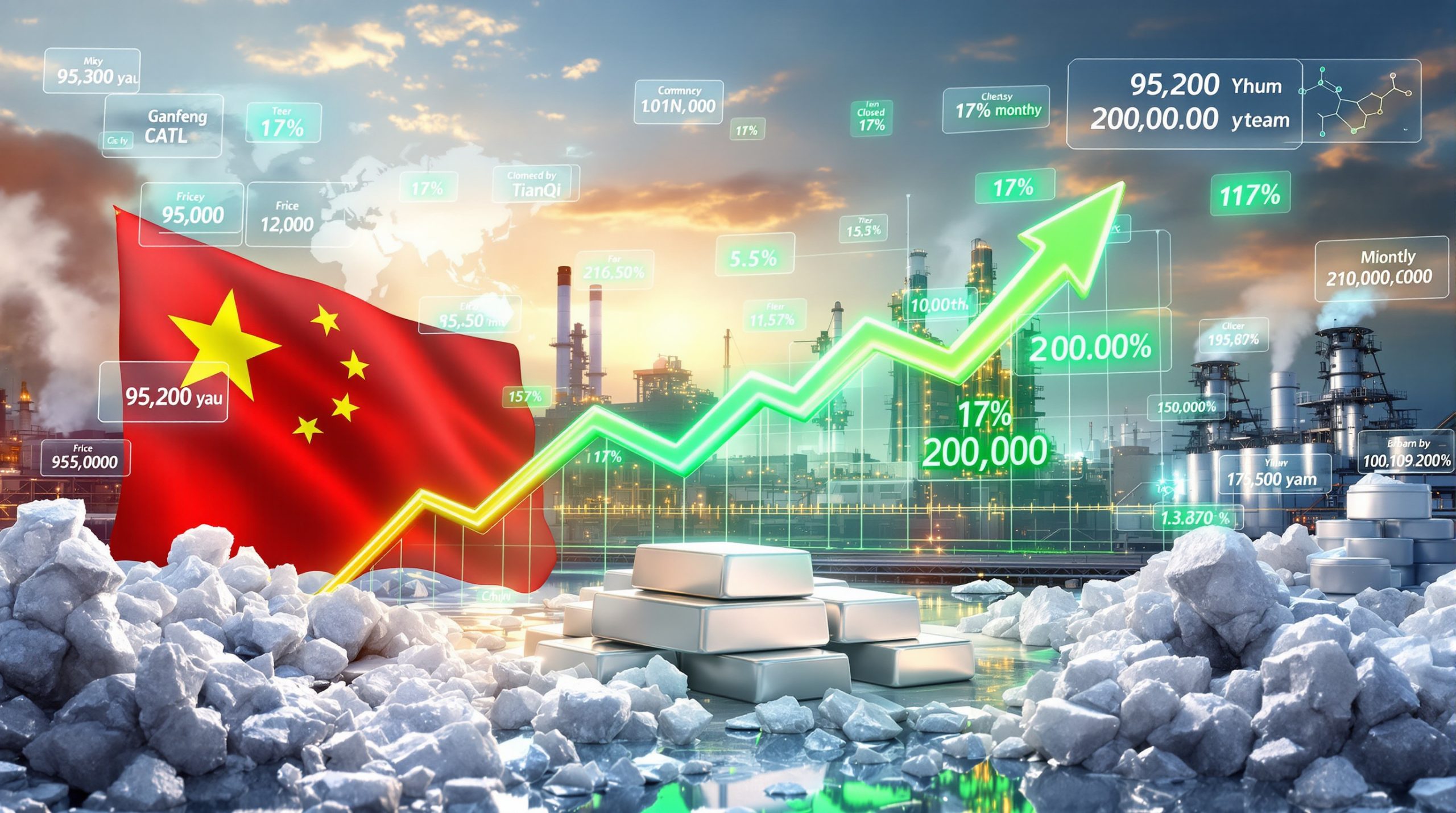The lithium price surge in China has captured global attention as the battery metal experiences its most significant rally in months. Trading levels reached 95,200 yuan ($13,401) per metric ton on November 17, 2025, marking the highest price point since June 2024. This dramatic recovery represents a 17% monthly gain for lithium carbonate futures, signaling a fundamental shift in market dynamics that had previously been characterized by oversupply conditions.
The Guangzhou Futures Exchange witnessed intense activity as the most-traded lithium carbonate contract surged 9% in a single trading session, approaching the daily upper limit. This price action reflects growing investor confidence in the battery metal's supply-demand rebalancing, particularly as manufacturing constraints begin to tighten available inventory.
Market Fundamentals Shift After Years of Oversupply
China's lithium market has undergone a remarkable transformation from the severe price corrections that followed the 2022 commodity boom. The current rally represents more than just speculative positioning, with underlying supply chain disruptions creating genuine market tightness across key production regions.
Industrial participants are increasingly recognising that the previous surplus conditions may be ending sooner than anticipated. Manufacturing bottlenecks, combined with accelerating demand from energy storage applications, have created a more balanced supply-demand environment that supports higher price levels.
Supply Chain Disruptions Create Market Tightness
The closure of CATL's Jianxiawo lithium mine in Yichun city, Jiangxi Province, has emerged as a critical factor supporting the lithium price surge in China. This facility, described as CATL's flagship lithium operation, remains shuttered due to operating licence renewal delays, forcing the battery giant to source lithium ore externally during November 2025.
The geographic concentration of lithium production in Jiangxi Province has amplified the impact of regulatory delays on market supply. When major facilities face licensing challenges, the ripple effects extend throughout China's interconnected battery supply chain, creating procurement pressures that ultimately translate into higher commodity prices.
CATL's shift to external sourcing demonstrates the real-world impact of supply disruptions on even the largest market participants. Furthermore, this strategic adjustment highlights how regulatory processes can create unintended market consequences, particularly when they affect facilities that represent significant production capacity.
How Are Industry Leaders Forecasting 2026 Demand Growth?
Industry executives are expressing unprecedented optimism about lithium demand prospects, with some of the sector's most influential leaders projecting growth rates that could fundamentally reshape market dynamics. These forecasts are driving investor enthusiasm and contributing to the current price momentum across Chinese lithium markets.
Ganfeng Chairman's Bold Market Predictions
Li Liangbin, Chairman of Ganfeng Lithium Group, has provided the market with ambitious growth projections that sparked the recent lithium price surge in China. His forecast of 30-40% demand growth for 2026 represents one of the most bullish outlooks from a major industry participant, suggesting annual consumption could reach 1.9 million tons.
These projections extend beyond simple volume increases, with Li predicting that strong demand fundamentals could drive lithium carbonate prices above 150,000 yuan per ton, with potential scenarios reaching 200,000 yuan per ton. Such price levels would represent more than double the current trading levels, indicating confidence in a dramatic supply-demand imbalance.
The timing of these statements, delivered at an industry conference and reported by Cailian media, demonstrates how executive commentary can immediately impact commodity pricing. The 7.48% gain in Ganfeng's stock price following the announcement reflects investor appetite for companies positioned to benefit from the projected demand surge.
Energy Storage Sector Driving Consumption Patterns
China's energy storage sector expansion represents a fundamental demand driver supporting lithium price recovery. The transition from grid-scale battery installations to widespread commercial and residential deployment is creating sustained consumption patterns that extend beyond cyclical electric vehicle production.
Battery storage applications require different lithium chemistry specifications compared to automotive uses, creating diverse demand streams that reduce market volatility. In addition, this sector diversification provides underlying support for commodity prices even during periods of electric vehicle market uncertainty.
The integration of renewable energy sources with battery storage systems is accelerating lithium consumption at unprecedented rates. Wind and solar installations increasingly require battery backup capabilities, creating a correlation between renewable energy deployment and lithium demand that reinforces long-term consumption growth.
What Role Do Supply Constraints Play in Price Volatility?
Supply-side factors have emerged as the primary catalyst for China's lithium price surge, with production disruptions creating immediate market tightness that overshadows longer-term demand projections. These constraints demonstrate how quickly commodity markets can shift from surplus to scarcity conditions.
Strategic Mine Closures and Regulatory Impacts
The regulatory environment surrounding lithium mining operations has become increasingly complex, with environmental compliance requirements creating operational uncertainties for major producers. Operating licence renewal processes, while designed to ensure sustainable practices, can inadvertently create supply disruptions when facilities face extended approval timelines.
CATL's experience with the Jianxiawo mine illustrates how regulatory processes can affect even the most established operations. The facility's continued closure through November 2025 demonstrates that licensing delays can persist longer than initially anticipated, creating extended periods of supply constraint.
Environmental compliance standards for lithium extraction and processing operations continue evolving, requiring operators to adapt their procedures and potentially invest in upgraded equipment. However, these regulatory adaptations, while beneficial for long-term sustainability, can create short-term production disruptions that impact market supply.
Furthermore, developments in Australia lithium innovations have shown how regulatory frameworks can both support and constrain production capabilities across different jurisdictions.
Export Control Measures Reshaping Global Markets
China's position as the dominant lithium processing nation creates opportunities to influence global supply chains through strategic policy measures. Export restrictions on lithium-processing technology and equipment help maintain domestic value-added capabilities while creating potential supply constraints for international competitors.
The concentration of lithium carbonate refining capacity within China means that domestic policy decisions can have far-reaching implications for global battery supply chains. When Chinese facilities face production constraints, the limited alternative processing capacity amplifies price impacts across international markets.
Technology transfer restrictions ensure that China maintains its competitive advantages in lithium processing, creating barriers for other nations attempting to develop independent supply chains. These measures support domestic market control while potentially contributing to global supply tightness.
Which Companies Are Benefiting from the Price Rally?
The lithium price surge in China has generated significant investor interest in publicly traded producers, with stock market performance reflecting optimism about improved profitability prospects. November 17, 2025, witnessed particularly strong gains across the sector following industry demand forecasts.
Stock Performance Among Major Lithium Producers
Chinese lithium companies experienced substantial stock price appreciation as investors responded to improved commodity pricing and optimistic demand forecasts:
| Company | Single-Day Gain | Market Response |
|---|---|---|
| Ganfeng Lithium | +7.48% | Leadership commentary impact |
| Chengxin Lithium | +10.01% | Processing capacity benefits |
| Tianqi Lithium | +9.87% | Global supply exposure |
These stock movements occurred on the same trading session that lithium carbonate futures approached daily trading limits, demonstrating the correlation between commodity pricing and equity valuations. The synchronised gains across multiple companies indicate broad-based investor confidence in sector recovery.
Ganfeng Lithium's stock performance reflects the market's response to Chairman Li Liangbin's demand growth projections. As one of China's largest lithium producers, the company's outlook carries significant weight with investors evaluating sector prospects.
Market Capitalisation Changes and Investment Flows
The equity market response to lithium price improvements suggests that investors are positioning for sustained commodity price recovery rather than short-term speculation. Trading volumes and price momentum indicate institutional participation in the sector rally.
Investment flows into lithium producers reflect growing confidence that the market has moved beyond the oversupply conditions that characterised 2023 and early 2024. The combination of supply constraints and demand growth projections has created a more favourable investment environment for sector participants.
Merger and acquisition activity within China's lithium sector may accelerate as improved pricing creates opportunities for consolidation. Companies with strong production assets and processing capabilities are likely to attract increased strategic interest as market fundamentals strengthen.
How Does China's Market Dominance Affect Global Pricing?
China's commanding position across multiple stages of the lithium supply chain creates significant influence over global commodity pricing mechanisms. This market dominance extends from mining operations through processing, refining, and battery manufacturing, creating integrated value chains that can respond rapidly to domestic policy and market conditions.
Processing and Refining Control Mechanisms
The concentration of lithium carbonate processing capacity within China means that domestic market conditions directly influence international pricing dynamics. When Chinese facilities experience supply constraints or increased demand, these effects transmit rapidly through global supply chains due to limited alternative processing capacity.
Vertical integration across Chinese lithium companies creates operational efficiencies that provide competitive advantages over international competitors. This integration allows for coordinated responses to market conditions, potentially amplifying price movements when supply-demand imbalances develop.
The Guangzhou Futures Exchange serves as the primary price discovery mechanism for lithium carbonate in Asia, with trading activity influencing spot market pricing across international markets. Daily trading limits and circuit breaker mechanisms can create concentrated price movements that affect global commodity pricing.
For instance, Argentina lithium insights demonstrate how regional markets respond to Chinese pricing signals, even when local supply conditions differ significantly.
Strategic Export Considerations
China's lithium processing technology and equipment export restrictions help maintain domestic competitive advantages while creating potential supply chain vulnerabilities for international battery manufacturers. These policies support domestic value-added activities while influencing global supply chain development.
The geographic concentration of lithium processing capabilities creates strategic considerations for international battery manufacturers evaluating supply chain resilience. Diversification efforts require substantial investments in alternative processing capacity, which may take years to develop.
Policy coordination between Chinese lithium producers and government agencies can create synchronised responses to market conditions, potentially amplifying price movements during periods of supply-demand imbalance.
What Are the Long-Term Implications for Battery Supply Chains?
The current lithium price surge in China signals broader transformations occurring within global battery supply chains, with implications extending well beyond short-term commodity pricing. These changes reflect structural shifts in demand patterns, supply chain geography, and strategic resource management.
Strategic Stockpiling and Inventory Management
Industrial users of lithium are reassessing their procurement strategies in response to increased price volatility and supply chain uncertainties. Strategic stockpiling has become more attractive as companies seek to reduce exposure to commodity price fluctuations and supply disruptions.
Battery manufacturers are evaluating optimal inventory levels to balance carrying costs against supply security concerns. The experience of CATL sourcing external lithium ore demonstrates how even integrated producers can face procurement challenges during supply disruptions.
Government reserve policies may play increasingly important roles in managing commodity market stability. Strategic reserves can help buffer supply shocks while providing policy tools for managing domestic market conditions during periods of international price volatility.
The development of a battery-grade lithium refinery in India exemplifies efforts to diversify processing capabilities outside China's sphere of influence.
Alternative Supply Source Development
International mining projects are receiving renewed attention as battery manufacturers seek to diversify supply sources beyond Chinese-controlled operations. These projects face significant development timelines and capital requirements, limiting near-term supply alternatives.
Processing capacity expansion outside China requires substantial technology transfer and capital investment. The complexity of lithium carbonate refining creates barriers for new entrants, supporting the continuation of Chinese market dominance in the medium term.
The Thacker Pass lithium mine represents a significant step towards US supply chain independence, though such projects require years to reach full production capacity.
Recycling technology advancement offers potential for reducing primary lithium demand, though current recycling capacity remains limited relative to growing battery consumption. The Chinese battery recycling breakthrough demonstrates how innovation can help address supply constraints.
Key Takeaways for Market Participants
Price Outlook and Risk Factors
The lithium price surge in China reflects a fundamental shift from oversupply conditions toward more balanced market dynamics. Supply-demand rebalancing appears to be occurring faster than many analysts anticipated, driven by production disruptions and accelerating demand growth in energy storage applications.
Key price drivers include:
• CATL's Jianxiawo mine closure creating immediate supply constraints
• Ganfeng chairman's 30-40% demand growth projection for 2026
• Energy storage sector expansion requiring sustained lithium consumption
• Regulatory delays affecting multiple Chinese production facilities
• Export control measures maintaining domestic supply chain advantages
Risk factors that could affect future pricing include regulatory resolution timelines, alternative supply source development, and potential demand growth slower than current projections. Market participants should monitor these factors when evaluating commodity exposure strategies.
Investment Considerations and Market Positioning
The combination of supply constraints and demand growth projections has created a more favourable investment environment for lithium producers. However, commodity price volatility requires careful risk management strategies for both industrial users and financial investors.
Strategic considerations include:
• Geographic diversification opportunities beyond Chinese-controlled supply chains
• Long-term contract structures to manage price volatility
• Processing capacity investments to capture value-added opportunities
• Recycling technology development for future supply sources
• Strategic inventory management balancing costs and supply security
The current market environment favours companies with established production capacity and integrated supply chains. Nevertheless, regulatory uncertainties and potential policy changes create ongoing risk factors that require continuous monitoring.
"The lithium market's dramatic reversal from oversupply to potential shortage conditions demonstrates how quickly commodity fundamentals can shift, particularly when supply disruptions coincide with accelerating demand growth in critical sectors like energy storage and electric vehicles."
Market participants seeking to understand lithium price dynamics should monitor Chinese regulatory developments, energy storage deployment rates, and alternative supply source progress. The interaction between these factors will likely determine whether current lithium pricing trends represent sustainable market fundamentals or temporary supply-demand imbalances.
Ready to Capitalise on the Next Major Lithium Discovery?
Discovery Alert's proprietary Discovery IQ model delivers real-time alerts on significant ASX mineral discoveries, instantly empowering subscribers to identify actionable opportunities ahead of the broader market. Understand why historic discoveries can generate substantial returns by exploring Discovery Alert's dedicated discoveries page, and begin your 30-day free trial today to position yourself ahead of the market.




